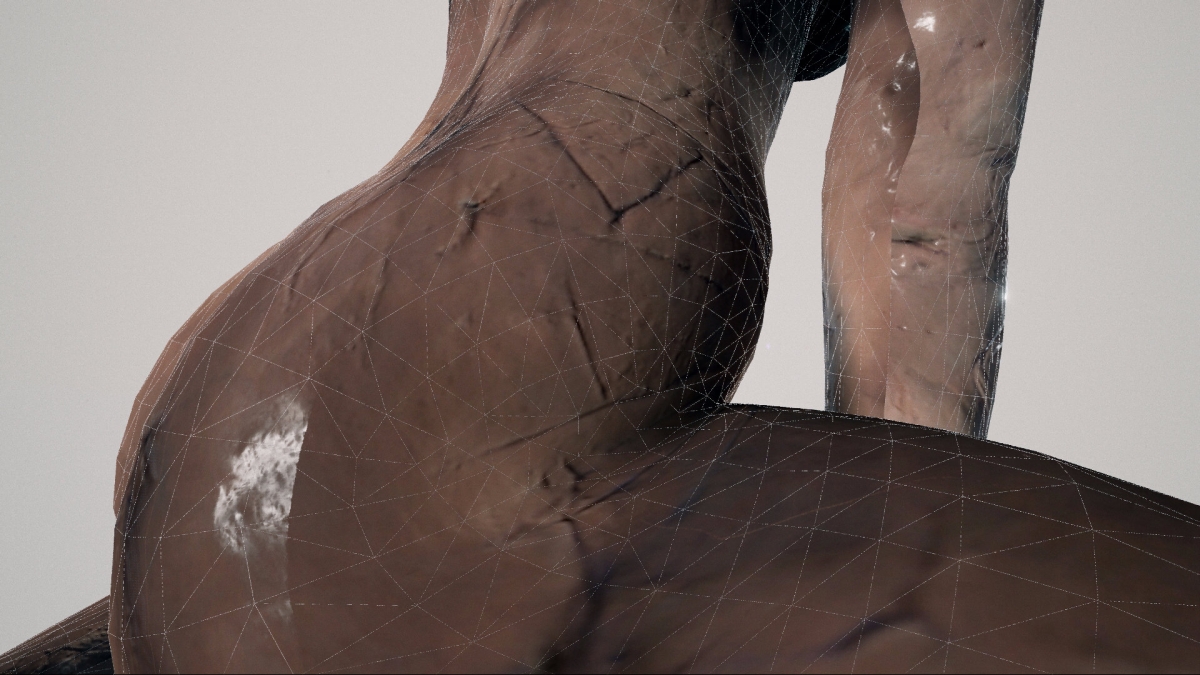War by Any Means
Rose-Anne Gush examines Sidsel Meineche Hansen’s Second Sex War through the lens of the female body and its concealed labour power in the high-tech gaming and porn spectacle
Second Sex War, Sidsel Meineche Hansen’s recent exhibition at Gasworks, explores the meaning and place of ‘woman’ within the current phase of capitalism with its phantasmagorical image regimes and affect producing industries.[1] It confronts the history and present of interminable wars between the sexes, as well as debates between feminists concerning sexuality and sex work: the anti-censorship and anti-porn struggles that have been ongoing since the 1980s.[2] The exhibition couples the pornographic imagination with various media and techniques, pitting CGI animations against laser cut woodcuts and clay reliefs, which figure as reproductions or indentations of the body.
I am interested in the particular ways that Second Sex War figures the relation between the phantasmagoria of the computer-generated image that obsesses over the body of ‘woman’, but also in how this image ‘conceals’ this body and its labour power, in the sense discussed by Lea Melandri:
Idealism, the oppositions of mind to body, of rationality to matter, originates in a two-fold concealment: of the woman’s body and of labour power. Chronologically, however, even prior to the commodity and the labour power that has produced it, the matter which was negated in its concreteness and particularity, in its ‘relative plural form’, is the woman’s body. Woman enters history having already lost concreteness and singularity: she is the economic machine that reproduces the human species, and she is the Mother, an equivalent more universal than money, the most abstract measure ever invented by patriarchal ideology.[3]
‘Woman’ has been mapped onto and maintained by her attachment to the invisible but reproductive labour that has been excluded from the wage and, by proxy, from public life. Her value is measured by her body in its reproductive function.[4] But also in psychoanalytic terms, woman ‘does not exist’, crowded out by man’s space in the symbolic. [5] [6] Second Sex War takes the body as its subject and object in order to work through this condition in the hope of transforming it.
 Image: Sidsel Meineche Hansen, SECOND SEX WAR, 2016. Installation View. Photo: Andy Keate.
Image: Sidsel Meineche Hansen, SECOND SEX WAR, 2016. Installation View. Photo: Andy Keate.
Suspended inside a wooden frame that is almost an exact replica of Bob Flanagan and Sheree Rose’s installation, Bob Flanagan’s Sick, from 1991, is a gaming screen. In the original work, inside the wooden BDSM frame there is a cruciform structure, constructed with video monitors showing Flanagan in various states of masturbatory pain. In Hansen’s response, on the gaming screen, every three minutes loops a video starring EVA v3.0, a 3D model that has featured in various of Hansen’s recent works, including the CGI film, Seroquel® (2014), and No Right Way 2 Cum (also featured in Second Sex War). Gaming is pitted against video, or stands as its logical conclusion. The CGI animation is titled DICKGIRL 3D(X) (2016). EVA v3.0 is a ‘post-human’ computer generated animation of an ungendered, or uncastrated, mannequin-like female-shaped figure complete with breasts without nipples, who proudly exhibits a ridiculous Benglis-esque prosthetic semi-transparent blue penile ‘genitalia prop’, pulsating with an electromagnetic current. Electronic music by Nkisi (Melika Ngobe Kolongo) that fuses tones of heavy breathing and electronic beats provides a rhythm to the animation. The object of a malign desire for this virtual white mannequin figure is a clay-coloured mutated body with strange, contorted limbs resembling human ones. It is a distorted body without a head calling to mind a present day Golem. Is it an unfinished being made by magic acts? A pure abstraction? A negation of representation or the figural? This body sometimes wraps itself around the dickgirl, who simultaneously pulls out handles from its torso. The sex portrayed is penetrative: the white animated figure perpetually, performatively fucks the brown clay-like character from a variety of different typically pornographic positions known as ‘pose sets’ purchased with the figure. The POV moves sideways, above, below, behind. Sometimes the dick resembles a knife, slicing in and out. Because of its scrappy construction and transparency, it never really ‘enters’ into the virtual brown blob but merely glides up and down, paradoxically renouncing penetration.
The styles of fucking, or ‘pose sets’, are ones that have been performed by humans, filmed using motion capture and then rendered into moves formed from grids that can be wrapped with colours and textures and are at a remove from their point of making. They are based on code but look photorealistic. Their image is the visual effect of an abstraction of a mass of data stored somewhere, on something, constructed by someone, separable from itself as an image, lacking the indexicality that defined analogue photography. EVA v3.0 moves effortlessly through her score of varying choreographed positions without the weight of flesh, bones, skin or gravity; without being held in a time marked by the explosions of history or future. Her rhythm begins slow paced, becomes more frenzied and then reverts back. It doesn’t feel novel, erotic or surprising. Sex imagery has been banalised by ubiquitous pornographic online advertising. Here, in art, that imagery is fixated upon and reproduced in a pure mimesis of the virtual. These two figures, CGI phallic mannequin and Golem, exist only in the domain of post-production; they do not add anything to an already existing video or film. But as appropriations of readymade virtual products, they ask how meaning is constructed and then attached to different representations of race and class, gender and sexuality.
DICKGIRL 3D(X) is not a media reproduction of life, as with previous generations of artists who have staged and then reproduced depictions of the body in sexual and non-sexual capacities. First wave body artists often staged their own bodies as both virile and inert, in efforts aimed either towards their ‘empowerment’ or to thematise struggles over the body that took place in times dominated by the retrenchment of conservative values: rights to abortion, anti-racism struggles, struggles against rape, battery and incest. These artists understood that the body, when functioning on the level of a sign, inaugurates oppression against women, the disabled, non-heterosexual and cis gendered.[7] Consider Linda Benglis’ advert for her own exhibition in the November 1974 issue of Artforum, where she posed with a giant and ridiculous dildo. Although the advert was understood at the time to contravene the aims of the women’s liberation movement, it was a playful representation of Benglis posing as phallic woman while simultaneously brutalising that very phallus. In contrast, DICKGIRL 3D(X) reflects on the intertwinement of the sex/gender system with labour and technology. DICKGIRL 3D(X) emerges from technology that is currently more acquainted with mega-budget Hollywood films, but is here made shabby and low-fi. She too is negated in concreteness and particularity because it is her purpose to be a base for many other forms; a commodity that can be repurposed and situated alongside all other commodities to add to their appeal; a pornographic commodity to produce affects in humans, most often aimed towards male pleasure and sexual gratification. DICKGIRL 3D(X) embodies an economic machine in an empty image space. She has no history, no future, no memory, no trauma, and no guilt. She does not reproduce, as in Melandri’s universally equivalent Mother, the human species, but rather points us back to her founding industry with its industrialisation of affects and its precarious and exploited living workers.
 Image: Sidsel Meineche Hansen, DICKGIRL 3D(X), 2016. Photo: Rose-Anne Gush
Image: Sidsel Meineche Hansen, DICKGIRL 3D(X), 2016. Photo: Rose-Anne Gush
Harun Farocki famously explored the ways in which new technologies that transformed warfare also transformed the human subject. In CGI there is no kino-eye. In DICKGIRL 3D(X) there is only a manufactured pure representation without a horizon, looping in a resistant stasis, produced after the fact of filming. On entering SECOND SEX WAR ZONE, wearing the Oculus Rift (a VR headset), I tip my head forward as if to look down, only to see the top of the avatar’s head. I see the outline of transparent eyeballs and a set of teeth. I am gazing down at her. Sometimes she summersaults into a position to face me. The only thing I can do to avoid the assault is to rotate my head on my shoulders and look away, all the while it continues over and over again. The only thing that shows me a location is reflected in her eyes: it’s the studio where the poses were recorded, the game given away by some stray props at the back of the room. I don’t see myself in the reflection.
If we follow the structure of the loop, halfway through, the white figure recedes into the background with her dick rising high. She floats for a moment, conjures a knife and makes slash marks that might read BI (sexuality that violates the dichotomy created in heterosexual identification) onto the surface of the brown blob, which sprays blood and for a moment dissolves. Its configuration is threatened. Its foundational grid is made legible. Then both figures threaten to dissolve. The white figure is transfigured, a shape-shifter, morphing to achieve brown skin the same colour as her clay object. She emerges ‘riding’ it. The two virtual beings are rendered with the same surface. This moment of cutting portrays an ambiguity. It is unclear if what occurs is the full introjection of the clay figure by EVA – it is pictured swallowed up by her, internalised through total and absolute domination and subsequent annihilation as she becomes it – or if they become identical with each other.
No Right Way 2 Cum is often described as a ‘feminist cumshot video’ also featuring EVA v3.0, and seems produced in a more self-conscious, consciousness raising register in reaction to 2014 legislation by BBFC banning female ejaculation from pornography produced in the UK.[8] It is structured to simply depict a scrawny, pink skinned, female avatar master-baiting, culminating in her spraying the screen with data fluid that forms the words that make its title. It is more visibly a fuck you to an industry which it is parodying.
The laser cut woodcuts that adorn the gallery walls throughout the exhibition seem to borrow their style from Paul Klee’s scribble line drawings but here are perfectly, mechanically burnt onto plywood with electrical discharges, thus re-industrialising them. In one, a gender ambiguous figure is fucking a car wheel, crudely pointing to the marriage of woman in/and advertising. Next to it, and most visible to me, was No Baby, depicting a woman lying on her back with her mouth open, wearing only pants, dreaming a warning sign against procreation: a no-baby sign. This could be an anti-life drawing as well as another protest against Melandri’s Mother. The woodcuts exist merely as wall pieces that contribute to the exhibition’s conceptual puzzle examining the currencies of craft and technology, old and new techniques, or the relinquishing of the hand to the machine. As figurative creatures they stay quietly flat in the background. On the adjacent wall there is a ceramic clay face mould titled Cite Werkflow Ltd., from 2015, which features the negative imprint of a nose and ears with a tear beneath the chin. Is this the face omitted from the clay Golem in DICKGIRL 3D (X)?
 Image: Sidsel Meineche Hansen, Cite Werkflow Ltd., 2015. Face imprint in clay, terra sigillata and vax. Photo: Andy Keate
Image: Sidsel Meineche Hansen, Cite Werkflow Ltd., 2015. Face imprint in clay, terra sigillata and vax. Photo: Andy Keate
In The Piano Teacher, Elfriede Jelinek travels the dialectic of domination and submission within the gendered body politic of the pornographic exploitation of women, approximating it to a kind of war. She describes the construction of her protagonist: ‘[h]er pregnant mother had visions of something timid and tender. Then, upon seeing the lump of clay that shot out of her body, she promptly began to mould it relentlessly in order to keep it pure and fine.’[9] Here it is metaphorical clay that animates the dynamic between the dominant mother who moulds and Erika Kohut who is moulded. Her clay quality connotes something incomplete and subject to its own surroundings, struggling to be for itself or in itself. In Second Sex War, clay functions as both a natural material, plastic until it is dried or fired, and metaphorically, when used in the CGI image to provoke uncertainty and to produce a question.
Second Sex War alludes to the problem of the place of the female in the concept and reality of women, and attempts to see beyond it. It asks us to question the currency of sexually affective imagery, its production, circulation and consumption as well as the relationship between the human body and the automation of certain production processes. The transformation of art remains within this context. However, it does this in a somewhat academic way, as a conceptual puzzle: it makes us think but not speculate or imagine. Can we consider what is virtual and real in virtual reality? Why is it that our present moment is obsessed with techno-fetishism as a programmatic way out of our current immiseration?[10] Hansen seems to be staking something else explicitly. The representation of sexuality on screen is decoupled from any struggles for liberation, with images that mark its commodification and subsumption. Hansen illuminates Melandri’s critique of idealism, posited as the result of the concealments of the woman’s body and labour power as the ‘most abstract measure ever invented by patriarchal ideology’. In Second Sex War, they are shown congealed together: the woman’s body as dead labour in its sexual capacity.
Within the marriage of techno-fetishism and the abolition of gender, Laboria Cuboniks claim at the end of their existentialist manifesto, Xenofeminism: ‘If nature is unjust, change nature.’[11] Second Sex War seems to hover above this claim, tempted by it, reconciled to a similar rationale. I might ask if it is nature that is unjust or exploitative and hidden social relations, concealed by dazzling, but not so special, effects. Second Sex War illuminates the transforming forces of image and material production and their reproduction as the reproduction of society as a whole, without the need for Melandri’s universal Mother, but does it offer us an image of anything beyond this reified world of deadened second nature? Does the image of this reified world point to another one? Is the war extended and then pulled back to face itself as critique of what it represents by means of mimetic re-enactment? Whatever our gender, we cannot be reconciled with this world.
Acknowledgements
Thanks to Demetra Kotouza for her comments and discussion.
Rose-Anne Gush is writing a PhD at the University of Leeds. She works on the concepts of the body and artistic labour in Contemporary art, film and literature in the Austrian context. She lives in London.
Info
Sidsel Meineche Hansen, SECOND SEX WAR, Gasworks, 17 MAR – 29 MAY 16
Footnotes
[1] The title is evidently a reference to de Beauvoir's The Second Sex and its questioning of how civilisation produces the feminine. Simone de Beauvoir, The Second Sex, H. M. Parshley (trans.), Jonathon Cape, 1956, p. 273.
[2] For an account of the content of one inaugurating conference on sexuality held at Barnard College in 1982, see: Barnard College Women’s Center, Diary of a Conference on Sexuality, Barnard College Women’s Center, 1982, which also constituted some of the basis for Hansen’s series of cross-institutional seminars and workshops that have taken place during the exhibition.
[3] Melandri is perhaps in danger of hypostatising this condition. Lea Melandri, L’infamia Originaria, Milano: Edizioni L’Erba Voglio, 1977, cited in Teresa de Lauretis, Technologies of Gender: Essays on Theory, Film and Fiction, Bloomington and Indianapolis: Indiana University Press, 1987, p. 130.
[4] Though to a lesser degree now in Europe and America, with the transformation of labour and marriage contracts before and then after WW2. See Christine Delphy, The Main Enemy: A Materialist Analysis of Women’s Oppression, Women’s Research and Resources, Centre Publications, 1977.
[5] See, for example, how Lacan’s quote, ‘la femme n’existe pas’, is reappropriated in Irigaray’s discussion of the disappearance of female subjectivity in the patriarchal symbolic order. Luce Irigaray, The Sex Which Is Not One, Ithaca: Cornell University Press, 1985.
[6] A counterpoint may be provided by Silvia Federici, for whom ‘woman’ has occupied a pivotal structural role within capitalist social relations and has been endowed with a revolutionary potential. In her essay ‘Wages against Housework’ (1974) she has argued that if housework could be integrated into the wage relation rather than being the invisible activity as ‘an act of love’, belonging to women in the home, it would have the power to destabilise capital and patriarchy by revealing the ways in which each relation is constituted through the other. This potential was contained in the possibility for women to withdraw this ‘value producing’ reproductive labour. Later, In Caliban and the Witch (2004), Federici argues against purely negative notions of ‘woman’ or the female body, which she wants to politicise and make into a terrain for struggle, against post-Lacanian feminism where ‘woman’ is marked out as a negative space built around the lack of symbolic power.
[7] See, for example, works by Carolee Schneeman; VALIE EXPORT; Martha Rosler; Adrian Piper; Ulrike Rosenbach; Yvonne Rainer; Gina Pane; Hannah Wilke.
[8] Christopher Hooton, ‘A long list of sex acts that just got banned in UK porn’, Independent, 4 December 2014. http://www.independent.co.uk/news/uk/a-long-list-o...
[9] Elfriede Jelinek, The Piano Teacher, Joachim Neugroschel (trans.), London: Serpent’s Tail, 1989 p.23.
[10] See the scathing review of Nick Srnicek and Alex Williams’ Inventing the Future, by DeArrest Editorial Collective, ‘Demeaning the Future’, Mute, 13 April 2016. http://www.metamute.org/editorial/articles/demeani...
[11] Laboria Cuboniks, Xenofeminism: A Politics For Alienation, June 2015. http://www.laboriacuboniks.net/qx8bq.txt
Mute Books Orders
For Mute Books distribution contact Anagram Books
contact@anagrambooks.com
For online purchases visit anagrambooks.com







